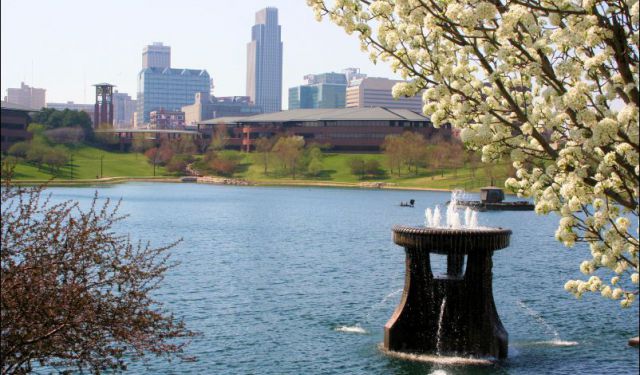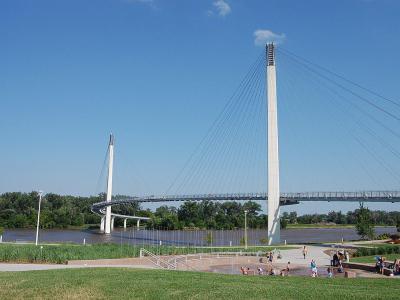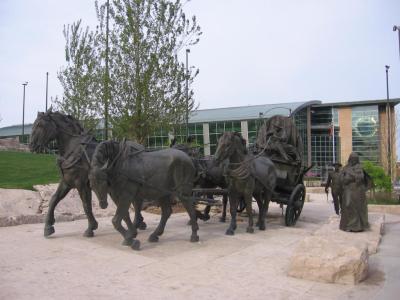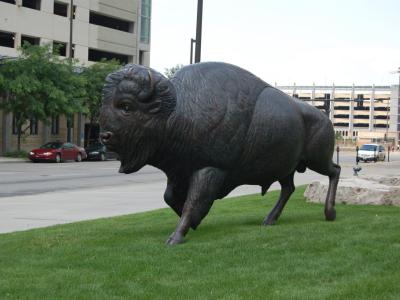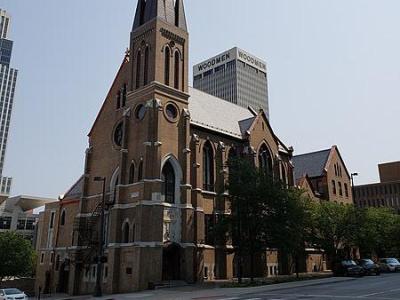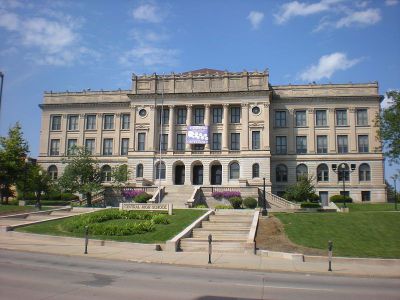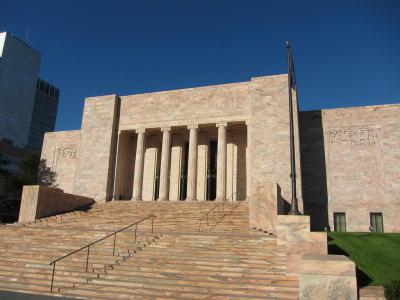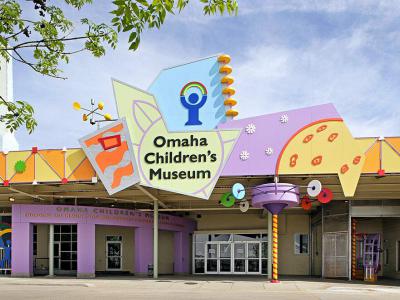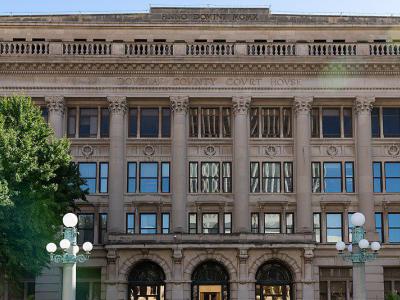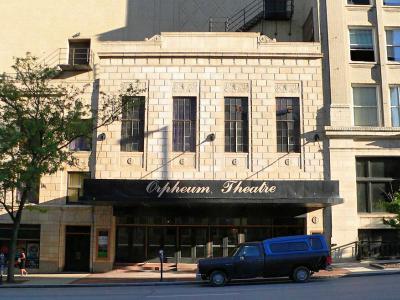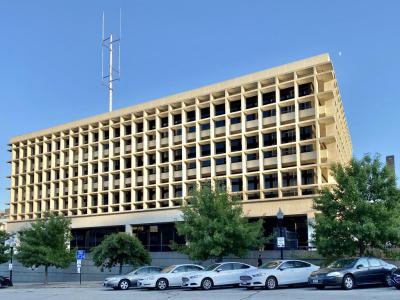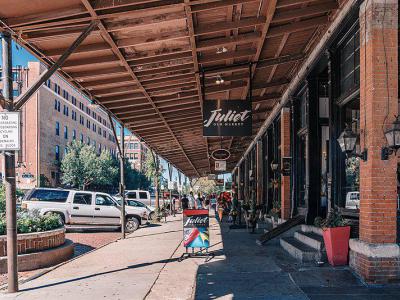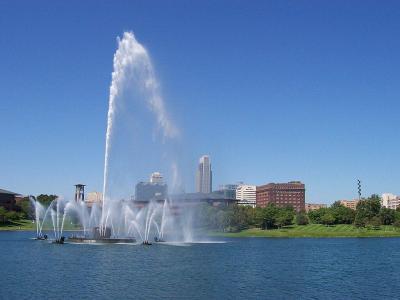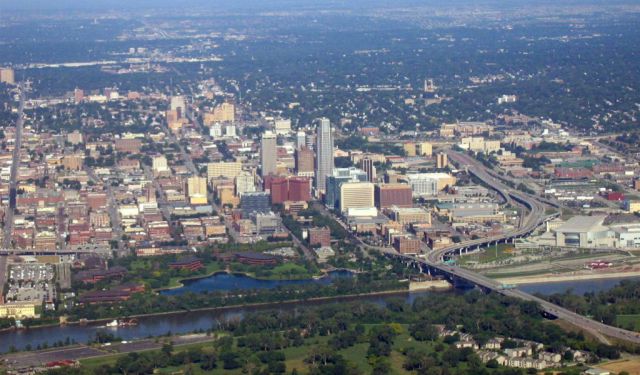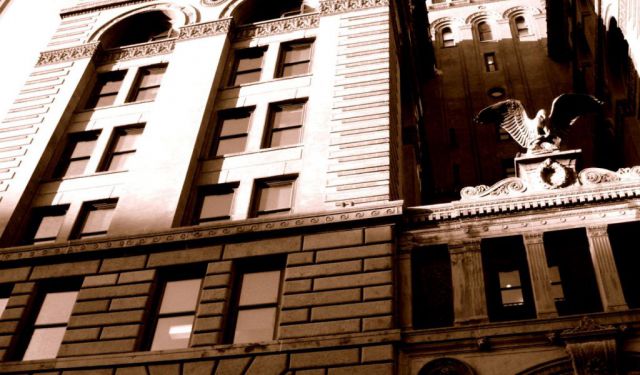Omaha Introduction Walking Tour (Self Guided), Omaha
Omaha is the largest city in the state of Nebraska. Known for its pioneer history, museums and cultural centers Omaha is home to nationally and regionally significant landmarks. The city has more than a dozen historic districts, interesting commercial, religious and educational sights which attract a lot of tourists to Omaha City.
How it works: Download the app "GPSmyCity: Walks in 1K+ Cities" from Apple App Store or Google Play Store to your mobile phone or tablet. The app turns your mobile device into a personal tour guide and its built-in GPS navigation functions guide you from one tour stop to next. The app works offline, so no data plan is needed when traveling abroad.
Omaha Introduction Walking Tour Map
Guide Name: Omaha Introduction Walking Tour
Guide Location: USA » Omaha (See other walking tours in Omaha)
Guide Type: Self-guided Walking Tour (Sightseeing)
# of Attractions: 12
Tour Duration: 3 Hour(s)
Travel Distance: 6.5 Km or 4 Miles
Author: DanaOffice
Sight(s) Featured in This Guide:
Guide Location: USA » Omaha (See other walking tours in Omaha)
Guide Type: Self-guided Walking Tour (Sightseeing)
# of Attractions: 12
Tour Duration: 3 Hour(s)
Travel Distance: 6.5 Km or 4 Miles
Author: DanaOffice
Sight(s) Featured in This Guide:
- Bob Kerrey Pedestrian Bridge
- Pioneer Courage Park Monuments
- Spirit of Nebraska Park Monuments
- St. Mary Magdalene Church
- Omaha Central High School
- Joslyn Art Museum
- Omaha Children's Museum
- Douglas County Courthouse
- Orpheum Theater
- Omaha Police Memorial
- Old Market
- Heartland of America Park
1) Bob Kerrey Pedestrian Bridge (must see)
Bob Kerrey Pedestrian Bridge is known as the longest pedestrian bridge that links two states. Its shape is curvilinear with two pylons equipped with LEDs that reflects a beautiful view at night. The bridge was finished in 2008. Its length is 3,000 ft. with landings, its walkway width is 15 ft. wide, and the height of the two single pylons is 210 ft. By building the bridge, the architect made special considerations for the environment, and added interactive sculptures that makes this bridge popular to visit.
2) Pioneer Courage Park Monuments
The monument in this park consists of several bronze sculptures that, taken all together, create a Wild West scene from the 19th century, in which four pioneer families with their wagons are heading west. It is known in history that Omaha was a gateway to the west. For this purpose, the First National Bank together with sculptors Blair Buswell and Ed Fraughton, created the monument in the middle of a business district as a symbol of courage, bravery, entrepreneurial spirit and impulse to explore the unknown. The monument was finished in 2003 and is considered one of the biggest monuments in the country.
3) Spirit of Nebraska Park Monuments (must see)
Spirit of Nebraska Wilderness Park symbolizes the link between the spirit of the past and optimism towards the future. It is one of the most expansive bronze monuments in the country. The monument starts from Pioneer Courage Park at 14th street, passes through 16th and Dodge Street and culminates at First National Tower Wintergarden. The monument reproduces the scene where nine bison, who were disturbed by people from Pioneer Courage Park, ran to Spirit of Nebraska Park and chased away a flock of 58 geese from the water. In such way the bison creates a link between Pioneer Courage Park and Spirit of Nebraska Park. The geese, having been disturbed by bison, soared from the granite fountain, where the water splash give the impression of a take off. The statues of flying geese are attached to buildings and light poles and the last geese, that represent the link to the future, are placed in the interior of the First National Tower Wintergarden.
4) St. Mary Magdalene Church
Saint Mary Magdalene, situated in downtown Omaha, was founded in 1868. At the beginning it was a small church. Afterwards, in 1903, the present church was built. This church was very popular and well-known because it was built “downwards”. Because of Omaha’s steep hills, (in 1919 Dodge Street was lowered), the new street level was at the mezzanine of the church. As a result, it was necessary to construct a new substructure. Here the masses last approximately thirty minutes.
5) Omaha Central High School
Omaha Central High School, or Omaha High School, was founded in 1859. The current building was designed by John Latenser, Sr. and built between 1900 and 1912. It is the oldest active high school building in the city. With an enrollment of around 2,500 students, today Central High School is the largest school in the state.
Central is a four-year high school with a traditional college preparatory curriculum, an honors and advanced placement program, and a diverse student body which includes international students from all over the world. Co-curricular activities such as athletics, clubs, honor societies, student government, drama, art, musical groups, speech, and debate are offered. Central High School is also a candidate for the IB Diploma Programme.
Central is a four-year high school with a traditional college preparatory curriculum, an honors and advanced placement program, and a diverse student body which includes international students from all over the world. Co-curricular activities such as athletics, clubs, honor societies, student government, drama, art, musical groups, speech, and debate are offered. Central High School is also a candidate for the IB Diploma Programme.
Sight description based on Wikipedia.
6) Joslyn Art Museum (must see)
The Joslyn Art Museum it is the only museum in the state with a comprehensive permanent collection. Although it includes works from antiquity to the present day, its greatest strengths are in 19th and 20th century American and European art. The museum opened in 1931, a gift to the people of Omaha from Sarah H. Joslyn in memory of her husband, George A. Joslyn.
It occupies a large and impressive Art Deco building designed by John and Alan McDonald, constructed of Georgia Pink marble, with 38 different marbles from all over the world in the interior, close to downtown Omaha. The decorative panels on the exterior were designed by sculptor John David Brcin and refer to the peoples of the plains - the original Native American inhabitants and the later European explorers and settlers. Inscriptions carved on the building were written by Hartley Burr Alexander. A substantial extension, designed by Lord Norman Foster, opened in 1994.
In 2008, construction began on the Joslyn Sculpture Garden. It opened in summer 2009 in time for the annual Jazz on the Green festival. The Garden features work from local and national artists as well as a reflecting pool and waterfall. The garden is now host to the annual Jazz on the Green festival, held every summer for the past 25 years in July and August. The festival lasts for 8 weeks and features local, regional, and national jazz musicians.
It occupies a large and impressive Art Deco building designed by John and Alan McDonald, constructed of Georgia Pink marble, with 38 different marbles from all over the world in the interior, close to downtown Omaha. The decorative panels on the exterior were designed by sculptor John David Brcin and refer to the peoples of the plains - the original Native American inhabitants and the later European explorers and settlers. Inscriptions carved on the building were written by Hartley Burr Alexander. A substantial extension, designed by Lord Norman Foster, opened in 1994.
In 2008, construction began on the Joslyn Sculpture Garden. It opened in summer 2009 in time for the annual Jazz on the Green festival. The Garden features work from local and national artists as well as a reflecting pool and waterfall. The garden is now host to the annual Jazz on the Green festival, held every summer for the past 25 years in July and August. The festival lasts for 8 weeks and features local, regional, and national jazz musicians.
Sight description based on Wikipedia.
7) Omaha Children's Museum (must see)
The Omaha Children's Museum is a nonprofit learning and exploration space for young people located at 500 South 20th Street. Operated as a private nonprofit organization the mission of Omaha Children's Museum is to engage the imagination and create excitement about learning. The museum was founded in 1976 by Karen Levin and a group of local educators. It began as a traveling group of exhibits and activities, and today occupies a 60,000-square-foot (5,600 m2) space in Downtown Omaha.
The permanent exhibits include the Creative Arts Center, which features a theater, Artist-in-Residence Studio, community sculpture and art island; the "Charlie Campbell Science and Technology Center", which houses the "Super Gravitron", a ball machine where balls powered by air wind and water travel through tubes and on rails, and an inventors workshop, pulley and vacuum chairs and the "Science Showplace" where live science presentations take place.
Other features include the "Imagination Playground", which is designed for young children; "Sandy’s Splish-Splash Garden", which is an interactive fountain area outside where kids can cool off. A 51-foot (16 m) kinetic tower and four 24-foot (7.3 m) whirligigs resembling giant pinwheels are located immediately outside the museum. In addition to its permanent exhibits, Omaha Children’s Museum regularly features traveling exhibitions and educational programming in art, science and humanities.
The permanent exhibits include the Creative Arts Center, which features a theater, Artist-in-Residence Studio, community sculpture and art island; the "Charlie Campbell Science and Technology Center", which houses the "Super Gravitron", a ball machine where balls powered by air wind and water travel through tubes and on rails, and an inventors workshop, pulley and vacuum chairs and the "Science Showplace" where live science presentations take place.
Other features include the "Imagination Playground", which is designed for young children; "Sandy’s Splish-Splash Garden", which is an interactive fountain area outside where kids can cool off. A 51-foot (16 m) kinetic tower and four 24-foot (7.3 m) whirligigs resembling giant pinwheels are located immediately outside the museum. In addition to its permanent exhibits, Omaha Children’s Museum regularly features traveling exhibitions and educational programming in art, science and humanities.
Sight description based on Wikipedia.
8) Douglas County Courthouse
The present Douglas County Courthouse is located at 1701 Farnam Street. Built in 1912, it was added to the National Register of Historic Places in 1979. Notable events at the courthouse include two lynchings and the city's first Civil Rights Era sit-in protest. Five years after it was opened, the building was almost destroyed by mob violence in the Omaha Race Riot of 1919.
The 1912 building was designed in the French Renaissance Revival style by local architect John Latenser, Sr.. Decorative stonework covers the structure's exterior, and the building serves as a prominent landmark in Downtown Omaha. Built south of the old courthouse, the building is six stories tall along Harney Street and five stories along Farnam. While the exterior walls are covered with unembellished Bedford stone, the interior halls have mosaic floors and marble wainscotings. Hardwood covers the interior of most offices, and vaults preserve county records. There were county offices on the main floor, second and third floors, and courtrooms on the fourth floor. The Douglas County Jail was on the fifth floor.
In September 1919, following Red Summer and racial riots in numerous industrial cities, a mob of thousands of men from South Omaha surrounded and attacked the Courthouse seeking to lynch an African-American worker named Willy Brown (accused of assaulting a white woman). Young men broke windows and climbed the outside of the building. After a few hours, thousands more gathered and they set the courthouse on fire to force the police to hand over the suspect.
The 1912 building was designed in the French Renaissance Revival style by local architect John Latenser, Sr.. Decorative stonework covers the structure's exterior, and the building serves as a prominent landmark in Downtown Omaha. Built south of the old courthouse, the building is six stories tall along Harney Street and five stories along Farnam. While the exterior walls are covered with unembellished Bedford stone, the interior halls have mosaic floors and marble wainscotings. Hardwood covers the interior of most offices, and vaults preserve county records. There were county offices on the main floor, second and third floors, and courtrooms on the fourth floor. The Douglas County Jail was on the fifth floor.
In September 1919, following Red Summer and racial riots in numerous industrial cities, a mob of thousands of men from South Omaha surrounded and attacked the Courthouse seeking to lynch an African-American worker named Willy Brown (accused of assaulting a white woman). Young men broke windows and climbed the outside of the building. After a few hours, thousands more gathered and they set the courthouse on fire to force the police to hand over the suspect.
Sight description based on Wikipedia.
9) Orpheum Theater
The Orpheum Theater is located at 409 South 16th Street and hosts programs best served by a more theatrical setting, including the Broadway Across America-Omaha series and Opera Omaha. It is listed on the National Register of Historic Places. The 2,600-seat proscenium theater was originally built in 1927 as a vaudeville house after John A. Creighton, a local philanthropist, donated a large amount of money towards its construction. It was a movie theater from the 1940s through 1975, when it received a $2 million renovation.
The Orpheum underwent a $10 million renovation in 2002. In 2004, the Orpheum Theater Skylink was added for increased convenience and accessibility to the Orpheum. The 200-foot-long elevated, enclosed and climate-controlled walkway connects the OPPD parking garage to the Orpheum Theater.
The Orpheum underwent a $10 million renovation in 2002. In 2004, the Orpheum Theater Skylink was added for increased convenience and accessibility to the Orpheum. The 200-foot-long elevated, enclosed and climate-controlled walkway connects the OPPD parking garage to the Orpheum Theater.
Sight description based on Wikipedia.
10) Omaha Police Memorial
The Omaha Police Memorial was made as to honor policemen who served and protected people in the name of safety and freedom. The sculpture depicts three figures (two policemen and a girl) made of bronze, that stand on a granite base. At this base you can see names and dates of policemen who were killed on duty. The memorial was made by John Lajba. It was finished in 1994 and is owned by Omaha city.
11) Old Market
The Old Market is a neighborhood that has many restaurants, art galleries and upscale shopping. The area retains its brick paved streets from the turn of the century, horse-drawn carriages, and covered sidewalks in some areas. It is not uncommon to see a variety of street performers, artists, and other vendors. The area is designated on the National Register of Historic Places as a historic district. There are also several specifically noted historic buildings within the district such as the Market House in Omaha's Jefferson Square, the P. E. Iler Block, the Windsor Hotel, Broatch Building, McClure-Smith Building, A. I. Root Building, George H. Lee Building etc.
Sight description based on Wikipedia.
12) Heartland of America Park (must see)
The Heartland of America Park is a public park located at 800 Douglas Street. The 31-acre (130,000 m2) park is situated between Interstate 80 and the Missouri River, and is adjacent to Gene Leahy Mall and the Old Market and connects to Lewis & Clark Landing.
Opened in 1990, the park was built on land recovered after the controversial demolition of the Jobbers Canyon Historic District. The area, filled with warehouses dating to the 1870s, was integral to the growth and development of Omaha. Along with the lake the park features a paved walking trail encircling area. There are three fountains, including a large, modern, $1.5 million dollar computerized fountain that projects water 300 feet (91 m) into the air and features a nighttime light show.
It is the second tallest fountain in the world behind number one in Sidney, Australia. The lake has a tour boat named the General Marion, with rides available in the summertime, and resident swans named Romeo and Juliet in honor of the play. There is also a monument to the 1898 Trans-Mississippi Exposition, and the late 1800s Waterworks Fountain, once located at the Webster Station, a railroad depot in North Omaha. The park is the site of the annual Taste of Omaha event.
Opened in 1990, the park was built on land recovered after the controversial demolition of the Jobbers Canyon Historic District. The area, filled with warehouses dating to the 1870s, was integral to the growth and development of Omaha. Along with the lake the park features a paved walking trail encircling area. There are three fountains, including a large, modern, $1.5 million dollar computerized fountain that projects water 300 feet (91 m) into the air and features a nighttime light show.
It is the second tallest fountain in the world behind number one in Sidney, Australia. The lake has a tour boat named the General Marion, with rides available in the summertime, and resident swans named Romeo and Juliet in honor of the play. There is also a monument to the 1898 Trans-Mississippi Exposition, and the late 1800s Waterworks Fountain, once located at the Webster Station, a railroad depot in North Omaha. The park is the site of the annual Taste of Omaha event.
Sight description based on Wikipedia.
Walking Tours in Omaha, Nebraska
Create Your Own Walk in Omaha
Creating your own self-guided walk in Omaha is easy and fun. Choose the city attractions that you want to see and a walk route map will be created just for you. You can even set your hotel as the start point of the walk.
Omaha Museums and Art Galleries Tour
Omaha is the largest city in the State of Nebraska. The city has many preserved old buildings, some of them museums. During this tour you will visit some of the most interesting museums and art galleries in the city. You will get acquainted with the history and art of the city and also will get to see some of the most beautiful works of art in the world.
Tour Duration: 2 Hour(s)
Travel Distance: 3.0 Km or 1.9 Miles
Tour Duration: 2 Hour(s)
Travel Distance: 3.0 Km or 1.9 Miles
Omaha Historical Florence Walk
Florence is the oldest community in Omaha; it is the place where the first structures and buildings in the State of Nebraska were built. The community has many sites of historical value. The first inhabitants of Florence were the Mormons who founded Winter Quarters and Cutler's Park. Take this tour to visit some of the most important places in Florence.
Tour Duration: 1 Hour(s)
Travel Distance: 2.2 Km or 1.4 Miles
Tour Duration: 1 Hour(s)
Travel Distance: 2.2 Km or 1.4 Miles
The Most Popular Cities
/ view all
